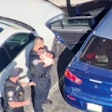Maybe this happened to you in the academy. A grizzled, veteran police officer stood up in front of your PT class and told you that as part of your training you would have to run four miles in 103-degree heat without stopping for water. His reason for such an order was academy tradition. That's how he did it in the academy, so you'd better be able to tough it out. And if you can't deal with it, then maybe you can't hack it as police officers.
That run was brutal, and you'll remember it all of your life. You made it, but others weren't so lucky. Some of your fellow cadets started feeling dizzy and nauseous, and then started collapsing before they reached the end.
It may seem obvious to everyone but old-fashioned football coaches, drill sergeants, and police academy PT instructors, but people exerting themselves in the hot sun need water. You need water for your body to function normally, and when your body is excessively hot, you need even more. To do your job and, in fact, to stay alive, you need to replace the water and electrolytes you use up by exerting energy. Whether you notice it or not, simply existing uses up water.
The goal of hydration is to provide the body with water, sodium, potassium, chloride, and bicarbonate in order to maintain a state of normal homeostasis. So it's not just water that keeps your body hydrated, but the electrolytes that help balance out your body's fluids.
Basically, the stuff in water keeps your body in working order-as long as you get enough of it. In addition, sufficient calories are needed to minimize body protein catabolism. Normal maintenance requirements provide water and electrolytes to replace those that are lost through urine, stool, and even through breathing and sweating.
In one day, a 155-pound male loses about 1,000 to 1,500 milliliters (ml) of water through urine, and about 1,000 ml of "insensible" water: 300 ml through the skin and 700 ml through breathing.
When your body becomes dehydrated, it is less able to dissipate the heat that it naturally produces. This can lead to rapid elevation in body temperature and heat exhaustion. Medical studies have demonstrated that even a 1-percent decrement in hydration can result in decreased physical and mental performance. At 7-percent dehydration, exhaustion and collapse are imminent.
Heat Illness
Heat exhaustion occurs because blood volume displacement to the skin causes marked cardiovascular stress. In the on-duty police officer, heat exhaustion can lead to headache, dizziness, nausea, diminished fine motor function, and confusion. If not treated this can progress to heatstroke, which is a true medical emergency, and life threatening if not treated.
In hot weather, an officer should be well hydrated before beginning his or her shift. The American College of Sports Medicine recommends that individuals drink 500 ml of fluid about two hours before physical activity to promote adequate hydration and allow for excretion of excess water. In general, replacing body fluid losses through drinking (we're talking water, here) can prevent dehydration.
Depending on thirst to tell you when to drink water often results in significant dehydration. Thirst provides a poor index of body water needs. If you're thirsty, you're probably already dehydrated.
A person can dehydrate by 2 to 8 percent of his or her body mass during physical activity. Believe it or not, about 60 percent of body mass is water. Dehydration of 2 to 8 percent is equivalent to a loss of 1 to 4 liters of body fluids for a person of 163 pounds body mass. That's a lot of water to be missing.
But your body's rate of water loss could vary based on several factors. The sweat rate, which greatly affects your rate of dehydration, is a function of individual metabolic rate, clothing, and climatic conditions-all of which change often.
Medications can also play a role in daily water loss. An officer taking medication such as thyroid replacement hormones or diphenhydramine (Benadryl) for allergies may be at risk because these and other medications can interfere with thermoregulation.[PAGEBREAK]
In addition, if a police officer has an underlying medical condition, this can cause dehydration or increased heat production. The decreased dissipation of heat can interfere with normal thermoregulatory mechanisms and make an officer more susceptible to heat illness while on duty.
Chronic medical conditions can also contribute to dehydration. These include diabetes mellitus, eating disorders, alcoholism, and illicit drug use. In fact, alcoholism and illicit drug use are among the 10 major risk factors for heat illness in the general population.
Obesity, a major health problem among the general population and for some police officers, places an individual at risk for heat illness. This is because of increased energy required to move extra mass, increased thermal insulation, and altered distribution of heat-activated sweat glands.
The color of urine has been suggested as a way to gauge and monitor hydration status. This method is based on a color-coding scheme in which individuals pay close attention to the color of their urine. Darker urine indicates a higher level of dehydration. If the urine is strongly yellow in color, the person is becoming dehydrated and needs more aggressive hydration.
Sports Drinks
In sports medicine circles, a hotly debated topic is what is the most appropriate fluid replacement. Confusion has arisen over a need for replacing electrolyte losses as well as the advantages of carbohydrate supplementation. Early medical investigators promoted sodium-containing fluids to prevent the development of hyponatremia (low blood sodium).
A study was conducted to look at the effectiveness of three commercial sports drinks, which were compared during 4 hours of physical activity. The beverages consisted of prepared solutions containing component individual minerals and glucose. All of the beverages proved equally effective in maintaining water and electrolyte balance during moderate physical performance. The benefit of consuming commercial sports drinks appears to be the enhanced good taste that then increases the voluntary beverage consumption, thereby reducing dehydration and preserving muscle function.
Cold replacement beverages increase the motility of the smooth muscles in the stomach, thereby speeding gastric emptying more rapidly than warm drinks. The commonly held belief that consumption of cold drinks causes stomach cramps has not been medically proven. Such a phenomenon is most likely related to the volume of the beverage consumed and not the temperature of the beverage. Drinking smaller volumes-for example, 150 to 250 ml every 15 to 20 minutes-will minimize bloating and maintain adequate hydration.
But if you're allergic to stinging insects, keep in mind that drinking sports drinks while on duty may attract bees and yellow jackets, which could put an officer at risk for sting-induced allergic reactions.
To prevent dehydration and heat illness while on duty, be aware of risk factors, alter behavior and physical activity to compensate for these risk factors, and most important, drink plenty of fluids.
BlackHawk
BlackHawk's new line of hydration gear includes the STRIKE Gen-4 Molle System Hydration System Carrier. It is large enough to carry a day's worth of water for those shifts when you can't easily refill your water supply.
The BlackHawk Hydrastorm Vector carries 100 ounces in its reservoir. The system features an Intercooler Venting System (IVS), four zippered pockets for carrying essential gear, and is backed by a lifetime guarantee. The Vector is also available in a 72-ounce version.
BlackHawk also offers a gas mask adaptor kit (GMAK) so you can have water where you need it even in an emergency. The complete tube kit is ready to go right out of the box. It easily screws on and off any HydraStorm reservoir and has a universal adaptor compatible with all NATO standard gas masks.
www.blackhawkindustries.com
CamelBak
The CamelBak PakTeen is a conveniently small canteen that holds 50 ounces of water. It can be used by itself or added to other hydration systems for added capacity.
For those times when you want a lot of water at the ready, the CamelBak Viper has a 102-ounce ergonomic hydration pack but a low profile. Its large access port provides for easy filling and its ventilated back panel keeps you cooler on the job.
The CamelBak TransFormer starts off with a sleek base system that can hold more water and gear when you add either its small packet or full-length compartment-or add both for extra capacity. The system holds 102 ounces in all.
www.camelbak.com
Med-Eng Systems
The BaquaPak from Med-Eng Systems is a hands-free hydration system that allows users to bite down on a mouthpiece and drink from a two-liter water reservoir, even while in riot gear.
The BaquaPak was designed to integrate with the company's V-Top five-piece, blunt impact, personal protection ensemble, engineered for crowd management and prison cell extraction operations.
The BaquaPak's water reservoir is contained in a lightweight, insulated pack that attaches easily to the back of the V-Top Torso. By attaching an adaptor, the BaquaPak can also be used in conjunction with a gas mask.
www.med-eng.com
Lawrence Heiskell, M.D., FACEP, FAAFP, is a reserve police officer with the Palm Springs (Calif.) Police Department and the SWAT team physician for that agency.
















